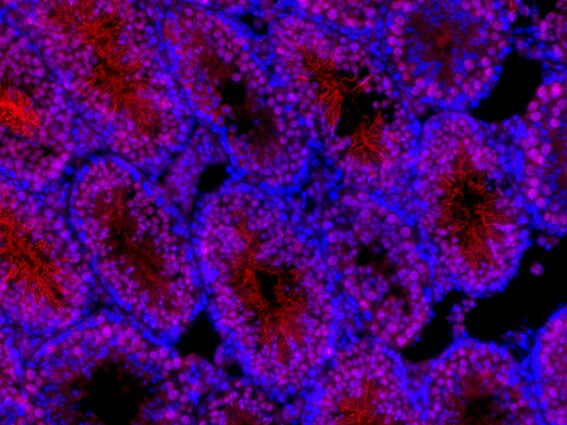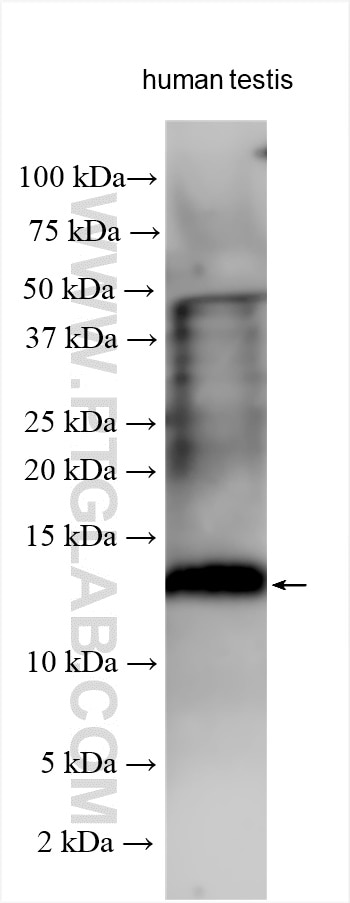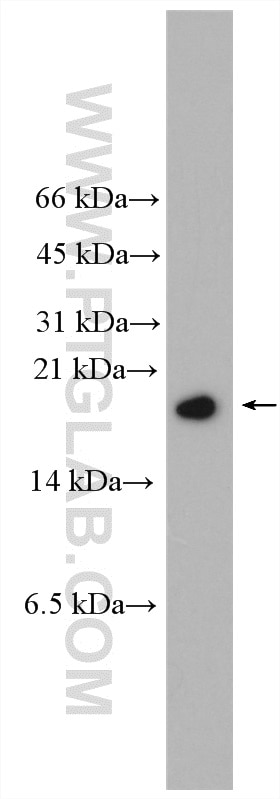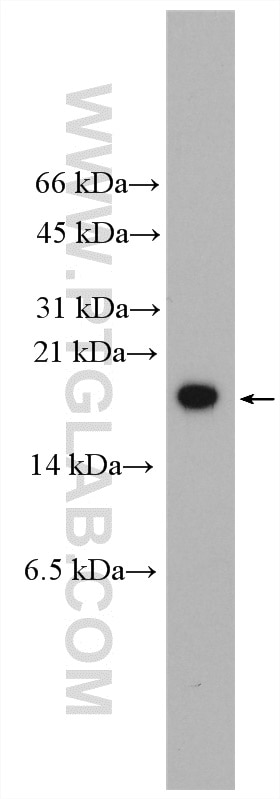PRM1 Polyklonaler Antikörper
PRM1 Polyklonal Antikörper für WB, ELISA
Wirt / Isotyp
Kaninchen / IgG
Getestete Reaktivität
human, Maus, Ratte
Anwendung
WB, IF, ELISA
Konjugation
Unkonjugiert
Kat-Nr. : 15697-1-AP
Synonyme
Geprüfte Anwendungen
| Erfolgreiche Detektion in WB | humanes Hodengewebe, Maushodengewebe, Rattenhodengewebe |
Empfohlene Verdünnung
| Anwendung | Verdünnung |
|---|---|
| Western Blot (WB) | WB : 1:200-1:1000 |
| It is recommended that this reagent should be titrated in each testing system to obtain optimal results. | |
| Sample-dependent, check data in validation data gallery | |
Veröffentlichte Anwendungen
| WB | See 5 publications below |
| IF | See 1 publications below |
Produktinformation
15697-1-AP bindet in WB, IF, ELISA PRM1 und zeigt Reaktivität mit human, Maus, Ratten
| Getestete Reaktivität | human, Maus, Ratte |
| In Publikationen genannte Reaktivität | human, Maus |
| Wirt / Isotyp | Kaninchen / IgG |
| Klonalität | Polyklonal |
| Typ | Antikörper |
| Immunogen | PRM1 fusion protein Ag8323 |
| Vollständiger Name | PRM1 |
| Berechnetes Molekulargewicht | 51 aa, 6 kDa |
| Beobachtetes Molekulargewicht | 13-20 kDa |
| GenBank-Zugangsnummer | BC003673 |
| Gene symbol | PRM1 |
| Gene ID (NCBI) | 5619 |
| Konjugation | Unkonjugiert |
| Form | Liquid |
| Reinigungsmethode | Antigen-Affinitätsreinigung |
| Lagerungspuffer | PBS with 0.02% sodium azide and 50% glycerol |
| Lagerungsbedingungen | Bei -20°C lagern. Nach dem Versand ein Jahr lang stabil Aliquotieren ist bei -20oC Lagerung nicht notwendig. 20ul Größen enthalten 0,1% BSA. |
Hintergrundinformationen
PRM1 is a 51 amino acid protein. PRM1 substitutes for histones in the chromatin of sperm during the haploid phase of spermatogenesis. They compact sperm DNA into a highly condensed, stable and inactive complex. PRM1 is expressed in testis. The calculated molecular weight of PRM1 is 9 kDa, but Phosphorylated protein is about 20 kDa. (PMID: 24818823)
Protokolle
| PRODUKTSPEZIFISCHE PROTOKOLLE | |
|---|---|
| WB protocol for PRM1 antibody 15697-1-AP | Protokoll herunterladen |
| STANDARD-PROTOKOLLE | |
|---|---|
| Klicken Sie hier, um unsere Standardprotokolle anzuzeigen |
Publikationen
| Species | Application | Title |
|---|---|---|
Environ Pollut Silica nanoparticles inhibiting the differentiation of round spermatid and chromatin remodeling of haploid period via MIWI in mice. | ||
Theriogenology Eif2s3y alleviated LPS-induced damage to mouse testis and maintained spermatogenesis by negatively regulating Adamts5 | ||
Reprod Sci Sertoli Cell-Conditioned Medium Induces Differentiation of Bone Marrow-Derived Mesenchymal Stem Cells to Male Germ-Like Cells in Busulfan-Induced Azoospermic Mouse Model | ||
Eur J Pharmacol 5- methylcytidine effectively improves spermatogenesis recovery in busulfan-induced oligoasthenospermia mice | ||
Cell Rep Med Decoding the pathogenesis of spermatogenic failure in cryptorchidism through single-cell transcriptomic profiling |
Rezensionen
The reviews below have been submitted by verified Proteintech customers who received an incentive for providing their feedback.
FH Chongil (Verified Customer) (08-19-2021) | Prm1 antibody may detect a wrong protein. Prm1 is detected in elongatid spermatids and testicular sperm heads. However, this antibody detected in spermatocytes, round spermatids, and sperm tails but not in sperm heads.
 |




